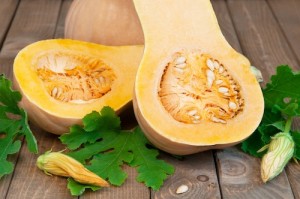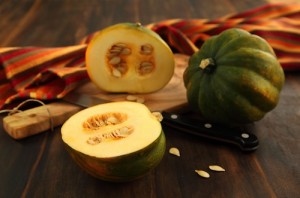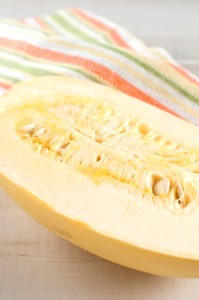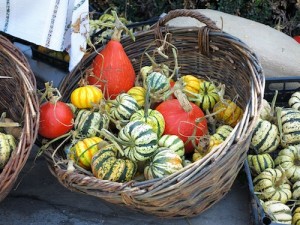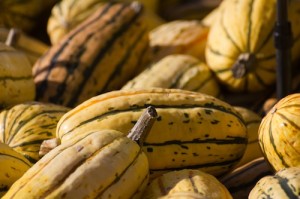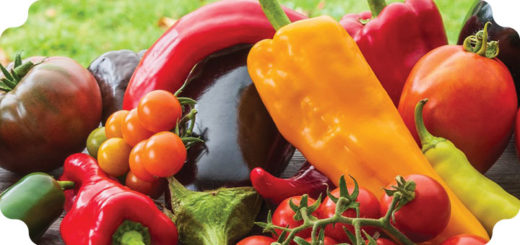All About Squash
All About Winter Squash
Gardening isn’t all about summer. Winter brings many delicious varieties of squash. They are nutritious, decorative, and grow well in coastal areas. They’re called winter squash not only because they grow well in winter but also because they keep well throughout winter.
Harvesting and Storage
Fruits are ripe if you cannot easily pierce the rind with your fingernail. Never rush to harvest winter squash, though, because immature fruits won’t store well. Unless pests or freezing weather threaten them, allow fruits to ripen until the vines begin to die back. Use pruning shears to cut fruits from the vine, leaving 1 inch of stem attached. Clean away dirt with a soft, damp cloth, and allow fruits to cure for two weeks in a spot that’s 70 to 80 degrees Fahrenheit. Store cured squash in a cool, dry place, such as your basement, a cool closet or even under your bed. Check every two weeks for signs of spoilage.
Saving Seeds
If you harvest your winter squash after the fruits have fully matured, saving seeds is simply a matter of rinsing, drying and storing the biggest, plumpest seeds that come across your cutting board. If stored in a cool, dry place, winter squash seeds remain viable for up to six years. Be sure to isolate varieties of the same species by planting them at opposite ends of the garden, or by growing one variety early in the season and another from midsummer to fall.
Types of Squash
Butternut squash combines rich flavor and smooth texture with natural resistance to squash vine borers. This bottle-neck shaped squash has a buff-brown rind and will store for six months or longer. It is delicious cooked and mashed with butter and a taste of brown sugar.
Acorn squash are ribbed, round fruits that have gold or green rinds. They mature quickly and will store for at least three months. Acorn squash is most commonly baked, but can also be microwaved, sautéed, or steamed. It may be stuffed with rice, meat or vegetable mixtures. The seeds of the squash are also eaten, usually after being toasted.
Spaghetti squash are full of stringy fibers that resemble pasta. The oblong fruits have smooth rinds that range from tan to orange, and they will store for three to six months. Spaghetti squash is not just a novelty anymore, but is now considered a serious low carbohydrate pasta substitute. To cook, cut in half, drizzle with olive oil, and roast. When finished, scoop out the inside with a fork (it looks like spaghetti) and mix with a little salt and pepper, butter or olive oil, and parmesan cheese.
Kabocha squash have a remarkably sweet and tender flesh with a slightly nutty flavor. The peel is really more of a rind and is difficult to cut. The dense, smooth, sweet flesh is so tasty it needs very little fuss in preparation. Roasting it or slicing and baking it with a bit of butter or oil and salt are all this delicious squash needs. The dense flesh also holds it’s shaped with cooked, even in liquids, which makes it perfect for using as chunks in soups or steamed dishes. It pairs well with ginger and sesame as well.
Delicata squash is small, oblong, and striped in bright yellow, dark green, and orange. Delicata does not store as easily as other squash because of its thin skin. They bruise easily so check the skin of the squash before purchasing. The flesh is sweet, nutty, and a bit drier than other squash with a distinct corn-like flavor. It is particularly delicious roasted with butter or stuffed and baked.
Winter squash is higher in calories than summer squash but is also higher in Vitamin A (beta carotene), Vitamin C, Potassium, Folic Acid and Niacin. Winter squash is a good source of fiber, and low in calories, fat and sodium. One small serving can provide a third of the daily requirement for vitamin C. The high beta-carotene content of winter squash causes the golden-orange color of the flesh.
Cooking With Winter Squash
There are plenty of newer trends in winter squash cuisine to try out. Savory risottos and ravioli are the trend but good old roasted squash is still popular. Sage is a great accent herb for winter squash, and some cooks brush maple syrup or honey onto chunks of baked (or grilled) squash to create a caramel glaze. Don’t forget about the seeds! Roast the rinsed, dried seeds at 275 degrees Fahrenheit until they just begin to pop, about 15 to 20 minutes. Season with sea salt and enjoy.
Squash and Ham Minestrone
2 smoked ham hocks (about 1½ lb.)
1 pound dried navy or cannellini (white kidney) beans
¼ cup plus 2 Tbsp. olive oil plus more for drizzling
1 large onion, finely chopped
2 leeks, white and pale-green parts only, finely chopped
2 small celery stalks with leaves (from celery heart), chopped
3 cloves garlic cloves, finely chopped
Kosher salt and freshly ground black pepper
1 butternut squash (about 2½ lb.), peeled, cut into ½” pieces
1 pound green beans, trimmed, cut into 1” pieces
8 cups low-sodium chicken broth
1 pound small pasta (such as tiny shells or pipette)
1 cup chopped fresh flat-leaf parsley, divided
2 bunches flat-leaf spinach, thick stems removed
Remove meat from ham hocks and cut into large pieces; set meat aside. Place navy beans and ham bones in a large pot; add cold water to cover by 2”. Bring to a boil, reduce heat, and simmer 2 minutes. Remove from heat, cover, and let stand 1 hour.
Heat ¼ cup oil in another large heavy pot over medium-low heat. Add ham hock meat, onion, leeks, celery, and garlic; season with salt and pepper. Cook, stirring occasionally, until vegetables are softened, about 20 minutes.
Add squash, green beans, navy beans and soaking liquid, broth, and bones to pot. Bring to a simmer over medium heat; reduce heat to low, cover, and gently simmer until navy beans are tender, 1½–2 hours.
When soup is almost finished cooking, cook pasta in a large pot of boiling salted water, stirring occasionally, until al dente. Drain and transfer to a large bowl. Drizzle with 2 Tbsp. oil and add ¼ cup parsley and toss to coat.
Discard ham bones. Add spinach and remaining ¾ cup parsley to soup. Parmesan cheese sprinkled on top along with a crusty French bread makes for a hearty meal.

